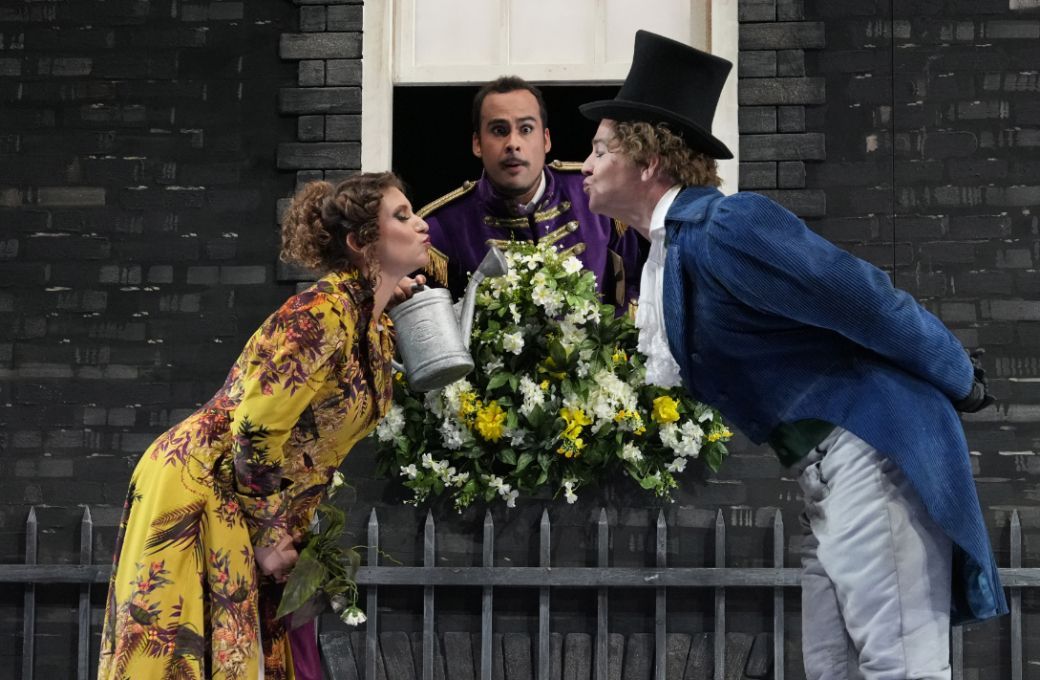Gioacchino Rossini composed La cambiale di matrimonio (“The Marriage Bill”) at the age of 18. Premiered in Venice in 1810, it was his first staged opera; though a short one-act farce, its score already showcases Rossini’s signature style.
Paola Leoci (Fannì), Ramiro Maturana (Norton), Jack Swanson (Edoardo Milfort)
© Amati Bacciardi
The plot hinges on a mercantile absurdity: Mr. Tobia Mill, an English merchant in Italy, receives a request from his Canadian associate Slook to “procure” a wife – framed as a commercial transaction secured by a cambiale (a promissory note, though crucially, no money is exchanged). Mill eagerly offers his daughter Fannì, unaware she loves Edoardo Milfort, a man without means. The resolution relies on Slook’s goodwill: he endorses the “marriage bill” to Edoardo, who then legally enforces it to wed Fannì, overriding her father’s objections.
The Rossini Opera Festival revived Laurence Dale’s successful traditional production in 2020. The set features the facade of the Mill household, which opens to reveal the interior like a doll’s house. Gary McCann’s costumes draw inspiration from 18th-century attire but use vibrant printed fabrics adorned with floral and landscape motifs. The stage direction is meticulous, allowing the opera’s lighthearted humour to shine across the centuries.
Pietro Spagnoli (Tobia Mill)
© Amati Bacciardi
Tobia Mill, portrayed as an irascible tyrant, reveals his cowardice when faced with superior authority. Pietro Spagnoli, a master of basso buffo roles, captured every facet of the character, using text and language not as obstacles but as tools for musical expression. His elegant, resonant baritone delivered pinpoint precision in rapid sillabato passages, exuded menace in his bullying and melted into mellifluous surrender in defeat.
Mattia Olivieri brought charisma and magnetic stage presence to the role of Slook, the Canadian suitor, delivering the part with his well-projected, smooth baritone. Though the character is notably older than Olivieri (Slook even names Edoardo his heir), his portrayal proved thoroughly convincing. Dressed as a Canadian hunter in leather attire and a raccoon hat, Slook arrived with an entourage that included a domesticated bear – a surprisingly humorous touch, thanks to actor Matteo Anselmi’s expressive performance despite the cumbersome costume.
Pietro Spagnoli, Ramiro Maturana, Mattia Olivieri, Jack Swanson, Paola Leoci
© Amati Bacciardi
The romantic leads were equally compelling: Jack Swanson, a tenore di grazia with a light, appealing timbre, and Paola Leoci, a nimble soprano soubrette with effortless high notes. Leoci shone in her final aria, “Vorrei spiegarvi il giubilo” (whose music Rossini later reused for the Rosina-Figaro duet in Il Barbiere), infusing it with sparkling coloratura. Rounding out the cast were the servants: baritone Ramiro Marturana as a lively Norton and soprano Inés Lorans as Clarina, who charmed with her aria di sorbetto, “Anch’io son giovane”.
Christopher Franklin conducted the Filarmonica Gioachino Rossini with energetic yet controlled drive, favouring broad phrasing and bringing out subtle orchestral details. Special recognition goes to Giulio Zappa, whose inventive and spirited fortepiano playing added vibrant character.
Jack Swanson (Edoardo Milfort)
© Amati Bacciardi
The farce itself runs just under ninety minutes. As a prelude, the Rossini Opera Festival presented Les soirées musicales, a collection of songs and duets with piano accompaniment published in 1835. This publication was a significant event in European musical life, marking Rossini’s return to composition after six years of silence following his final opera Guillaume Tell. The Festival performed Fabio Maestri’s 2019 orchestration of the work. These pieces have inspired orchestral arrangements in the past (notably by Wagner, who admired the stormy seascape depicted in the final duet) and Maestri’s version offers a fresh perspective. In the programme, he thoughtfully justifies his instrumental choices, though listeners accustomed to the original piano accompaniments may initially find the orchestration unfamiliar. Under Maestri’s baton, however, the Filarmonica Gioachino Rossini delivered a performance that was both meticulously detailed and deeply expressive. A highlight was the glass harmonica in La gita in gondola, its ethereal tones perfectly capturing the moonlit mystique of Venice.
Pietro Spagnoli, Inés Lorans, Ramiro Maturana, Mattia Olivieri, Paola Leoci
© Amati Bacciardi
The eight songs were performed by soprano Vittoriana De Amicis and tenor Paolo Nevi. De Amicis displayed a light soprano with effortless high notes, though her middle register lacked some projection. Her tone was crystalline, silvery in the upper range, with remarkable legato. In La danza (the collection’s most famous piece), her precision proved truly outstanding. Nevi (previously heard in the small role of Eacide in Zelmira) brought a naturally appealing timbre and instinctive, spontaneous delivery. His dynamic shading and vivid stage presence made for a compelling performance, though occasional strained high notes hinted at youthful nerves. Mezzo-soprano Andrea Niño and baritone Gurgen Baveyan joined them in the duets, rounding out the ensemble with polished musicianship.
****1
